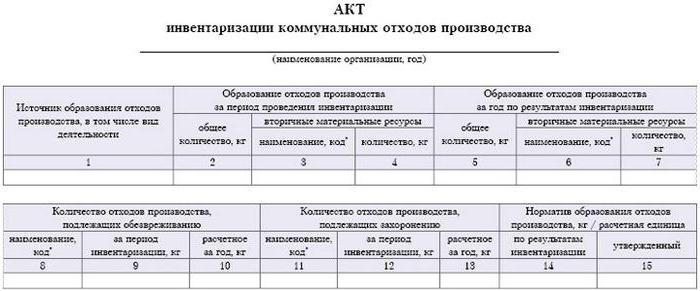Waste generation is associated with a low utilization of resources. Utility raw material acts as one of the common sources of environmental pollution. At present, this problem is very urgent, since there are no enterprises in which absolutely non-waste production. 
Environmental requirements
All waste materials that are formed on the territory of the Russian Federation are subject to certification. In addition, an inventory of waste is mandatory. It represents the accounting and calculation of the volume of waste materials generated at all enterprises. The act of inventory of production waste should contain a description of their specific indicators at the moment.
Normative base
The law "On Waste from Consumption and Production" establishes certain rules for all enterprises. A normative act, in particular, prescribes:
- Avoid the negative effects of hazardous substances and materials on human health and nature.
- Observe sanitary and epidemiological rules when handling waste.
- To carry out separate placement and collection of waste materials.
- Be sure to determine and keep track of the amount of industrial waste.
- Observe limiting standards regarding the accumulation of harmful and hazardous materials and substances.
- Search for consumers for the sale of raw materials.
- To conduct an inventory of waste.
- Carry out high-quality transportation of waste materials without creating accidents or losses.
- To place waste materials within the territory of the enterprise in the presence of appropriate limits issued by RTN authorities.

Inventory of production waste
It should be carried out at least once every 5 years. The company may provide for a reorganization or change in the direction of its work. In this case, accounting and calculation should be carried out for each unit repeatedly, regardless of whether the five-year period has expired or not. The act of inventory of production waste, in addition to specific indicators, must contain a description of the reasons why this waste material was formed. The statement also indicates the method of collection, accumulation, storage of substances and materials. It also calculates the amount of recyclable materials.
Stages
A waste inventory involves several stages. They must be performed sequentially. For the most effective implementation of the task, an instruction is provided. Inventory of waste - a process that requires increased attention. The prescriptions not only indicate the main stages, but also explain their specifics. First of all, a special order is drawn up. Inventory of waste involves the calculation of standards, the determination of quantitative indicators, etc. The results obtained are processed and used in the subsequent processing of hazardous materials and substances.
A document base
An inventory of production waste is carried out in accordance with the order of the head of the enterprise. This document:
- A special commission is appointed, its members are determined. She carries out a direct calculation of standards.
- A list of structural units is being formed in which an inventory of waste will be carried out.
- Responsible persons in specific departments are appointed.
The order provides the necessary information about the raw materials, and also indicates the possibility of its reuse. 
Division Accounting
The person responsible for complying with the waste management rules is the shop manager. For the period of his absence, this obligation is assigned to his deputy. All available types of waste substances and materials must undergo primary accounting. An entry for each category is entered in a special journal. It is filled every month by the responsible person.

Process goal
Inventory of waste makes it possible to determine:
- Sources of recycling. These, in particular, include directly shops, as well as technological processes at the enterprise, during which garbage appears.
- List of waste generated. This, in turn, allows you to set the names and codes of raw materials in accordance with the classifier.
- The annual rate of waste generation.
- Settlement standards.
- The list of waste that is sent for disposal, subsequent use, disposal.
Required Information
It should be said about the additional features that the instruction provides. Inventory of waste can be carried out using certain data about the enterprise. Such information includes:
- Information on the types of activities conducted by the enterprise.
- Credentials. They include, in particular, information from primary and general waste accounting books, the form statistical reporting (No. 2-OS), information from accounting documents on the receipts of raw materials from third-party companies, agreements on the transfer of waste to other enterprises, acts on the work performed, accompanying passports for the transport of garbage and other papers indicating the formation, use, storage, disposal, burial hazardous substances and materials.
- The layout of structures and buildings.
- Technological maps for production processes.
- Data on the consumption and characteristics of raw materials of all kinds, auxiliary preparations, substances, materials used or to be used in the activities of the enterprise.

During the process, other information can be used, in which there are indications of the operating modes of the equipment, the composition and volumes of the raw materials necessary for the production of products, etc.
Features
An inventory of production waste is carried out in strict accordance with regulatory requirements. Drawing up a statement is a prerequisite for its implementation. Materials that are recognized as waste should be identified in accordance with the established classification. At present, the all-Russian registry is absent, therefore, one should be guided by the lists that operate in the regions. If an inventory of the waste reveals a material or substance not previously announced in any source, it is permitted to assign the name on its own. In this case, it is subsequently necessary to contact the territorial environmental authorities to obtain a code.
Waste inventory: sample sheet
This document includes:
- Title page.
- Information on the results of accounting and calculation. They should be designed according to the model.
- The list of measures, including the utilization of raw materials, the definition of its qualitative and quantitative indicators, the development of standards for its education.
The act of inventory of waste must be signed by the chairman and members of the special commission. The document is agreed with the head of the enterprise and approved by him. 
Document Content
A waste inventory includes a description of:
- Land Plot.
- The source of the formation of recycled materials.
- The name of the waste and its generally accepted coding.
- Hazard class assigned.
- Substances and materials considered. This characteristic reflects the physicochemical parameters.These include the state of aggregation, volatility, solubility, key components that make up the composition.
- Accepted education standards.
- Temporary detention facilities.
- Disposal or disposal options. This can be a return to production, transfer to another storage area, transfer to other companies under a contract, etc.
- Other essential parameters.
Application Results
The information contained in the waste inventory act is used:
- When preparing documentation for obtaining permits for storage and disposal of waste materials or a comprehensive environmental license.
- Development of guidelines for the handling of hazardous and harmful substances and organization of their accounting.
- Calculation of limits for disposal and storage of waste.
- Maintaining statistical reporting.

Regulations
They are the maximum allowable volumes of waste that appear during the processing of a unit of material, the release of a single product or energy, the provision of services or the performance of work. Their development and coordination is regulated by a special provision approved by a government decree. The standards are set according to the information contained in the act of inventory of waste. Typically, these are indicators of measurements of the formation of waste materials for a specific period of time. In addition, when developing standards, the following data are taken into account:
- Technological regulations.
- Material balance.
- Specific consumption rates.
- Other documentation, including legal acts regulating the production of products, electric / thermal energy, the provision of services or the performance of work.
The development of standards is carried out by an enterprise or other entity in the form defined by the Ministry of Natural Resources. In practice, their establishment takes place in the process of drawing up instructions for the disposal of waste and obtaining permission for its disposal and storage.
Drafting Prescriptions
Inventory of waste allows you to get the data that the company subsequently uses when developing waste management rules for each specific unit and the entire enterprise as a whole. The written instructions are approved by the head of the organization and are transferred for approval to the territorial representation of the Ministry of Natural Resources. In this case, the project must be accompanied by:
- Statement.
- Application for storage / disposal of waste materials.
- Calculation of the annual volume of formation of hazardous / hazardous materials and substances, based on standards.
- Inventory sheet.

These documents are required to obtain permission for the disposal and storage of waste materials. Those responsible for waste management are appointed by order of the director of the enterprise.








